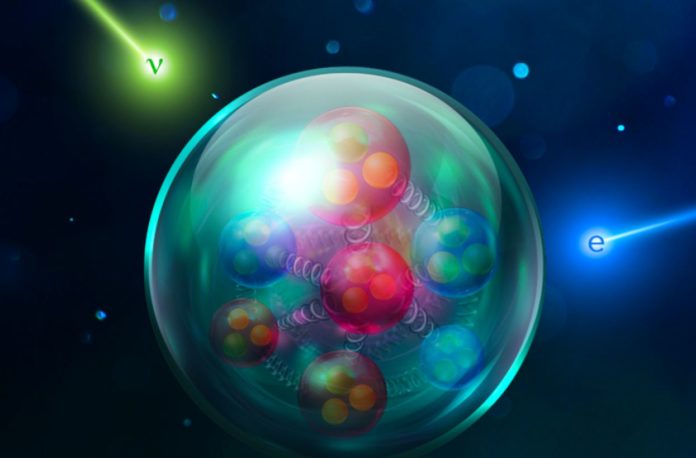Neutrinos may hold the key to finally answering a conundrum about the origins of our matter-dominated universe, and plans are underway for two huge, multibillion-dollar studies to uncover their secrets.
Now, a group of nuclear physicists has looked to the humble electron for direction on how to better prepare these experiments to capture vital data.
The study, which was conducted at the Thomas Jefferson National Accelerator Facility of the US Department of Energy and just published in Nature, demonstrates that considerable changes to neutrino models are required for the experiments to yield high-precision results.
Neutrinos are abundant in our cosmos, as they are produced in large quantities by stars. Despite their widespread presence, these shy particles rarely interact with matter, making research challenging.
“There is this phenomenon of neutrinos changing from one type to another, and this phenomenon is called neutrino oscillation. It’s interesting to study this phenomenon, because it is not well understood,” says Mariana Khachatryan, a co-lead author on the study.
Building massive, ultra-sensitive detectors to measure neutrinos deep underground is one technique to research neutrino oscillation. Neutrinos are more likely to interact with dense materials with big nuclei, which are common in detectors. As a result of these interactions, the detectors record a cascade of other particles. Physicists can utilize this knowledge to learn more about neutrinos.
“The way that neutrino physicists are doing that is by measuring all particles coming out of the interaction of neutrinos with nuclei and reconstructing the incoming neutrino energy to learn more about the neutrino, its oscillations, and to measure them very, very precisely,” explains Adi Ashkenazi – study’s corresponding author.
“The detectors are made of heavy nuclei, and the interactions of neutrinos with these nuclei are actually very complicated interactions,” Ashkenazi adds.
“Those neutrino energy reconstruction methods are still very challenging, and it is our work to improve the models we use to describe them.”
Modeling the interactions with a theoretical simulation called GENIE, which allows scientists to estimate the energy of the incoming neutrinos, is one of these ways. GENIE is a collection of models that individually aid scientists in reproducing specific elements of neutrino-nuclei interactions. Because so little is known about neutrinos, it’s difficult to test GENIE directly to assure it will deliver accurate and high-precision results from new data provided by future neutrino experiments like DUNE or Hyper-Kamiokande.
To put GENIE to the test, the team used a simple particle that nuclear physicists are far more familiar with: the electron.
“This exploits the similarities between electrons and neutrinos. We are using electron studies to validate neutrino-nucleus interaction models,” says Khachatryan.
Neutrinos and electrons have a number of common features. They are both elementary particles that are not affected by the strong force since they belong to the subatomic particle family known as leptons.
In this study, the scientists tested the identical incoming energy reconstruction techniques that neutrino researchers will employ using an electron-scattering variant of GENIE, dubbed e-GENIE. In instead of employing neutrinos, they used latest electron results.
“Electrons have been studied for years, and the beams of the electrons have very precise energies,” says Ashkenazi. “We know their energies. And when we are trying to reconstruct that incoming energy, we can compare that to what we know. We can test how well our methods work for various energies, which is something you can’t do with neutrinos.”
Experiments with the CLAS detector at Jefferson Lab’s Continuous Electron Beam Accelerator Facility, a DOE user facility, provided the study’s input data. CEBAF is the most advanced electron accelerator in the world for studying the nature of matter. The researchers used data that directly replicated the most basic situation addressed in neutrino experiments: interactions between helium, carbon, and iron nuclei that produced an electron and a proton (rather than a muon and a proton). The materials employed in neutrino experiment detectors are similar to these nuclei.
Furthermore, the team worked to ensure that the electron version of GENIE was as similar to the neutrino version as possible.
“We used the exact same simulation as used by neutrino experiments, and we used the same corrections,” explains Afroditi Papadopoulou, co-lead author on the study. “If the model doesn’t work for electrons, where we are talking about the most simplified case, it will never work for neutrinos.”
Even in this simplest scenario, precise modeling is essential since raw data from electron-nucleus interactions only half of the time reconstructs to the right incoming electron beam energy. This effect can be accounted for and the data corrected with a decent model.
GENIE, on the other hand, did significantly worse when used to model these data events.
“This can bias the neutrino oscillation results. Our simulations must be able to reproduce our electron data with its known beam energies before we can trust they will be accurate in neutrino experiments,” says Papadopoulou.
“The result is actually to point out that there are aspects of these energy reconstruction methods and models that need to be improved,” says Khachatryan. “It also shows a pathway to achieve this for future experiments.”
The next stage in this research will be to test specific target nuclei that neutrino researchers are interested in, as well as a wider range of incoming electron energies. The ability to compare these precise results will aid neutrino researchers in fine-tuning their models.
The goal, according to the research team, is to create broad agreement between data and models, which will assist DUNE and Hyper-Kamiokande achieve the high-precision results they predict.
Source: 10.1038/s41586-021-04046-5
You were reading: This can bias the neutrino oscillation results
